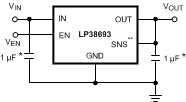-
LP3869x/-Q1 500-mA Low-Dropout CMOS Linear Regulators Stable With Ceramic Output Capacitors SNVS321O January 2005 – December 2015 LP38691 , LP38691-Q1 , LP38693 , LP38693-Q1
PRODUCTION DATA.
-
LP3869x/-Q1 500-mA Low-Dropout CMOS Linear Regulators Stable With Ceramic Output Capacitors
- 1 Features
- 2 Applications
- 3 Description
- 4 Revision History
- 5 Pin Configuration and Functions
- 6 Specifications
- 7 Detailed Description
- 8 Application and Implementation
- 9 Power Supply Recommendations
- 10Layout
- 11Device and Documentation Support
- 12Mechanical, Packaging, and Orderable Information
- IMPORTANT NOTICE
Package Options
Mechanical Data (Package|Pins)
- NGG|6
Thermal pad, mechanical data (Package|Pins)
Orderable Information
LP3869x/-Q1 500-mA Low-Dropout CMOS Linear Regulators Stable With Ceramic Output Capacitors
1 Features
- Wide Input Voltage Range (2.7 V to 10 V)
- All WSON Options are Available as AEC-Q100 Grade 1
- 2% Output Accuracy (25°C)
- Low Dropout Voltage: 250 mV at 500 mA (Typical,
5 V Out) - Precision (Trimmed) Bandgap Reference
- Ensured Specifications for –40°C to 125°C
- 1-µA Off-State Quiescent Current
- Thermal Overload Protection
- Foldback Current Limiting
- Ground Pin Current: 55 µA (typical) at full load
- Enable Pin (LP38693)
2 Applications
- Hard Disk Drives
- Notebook Computers
- Battery-Powered Devices
- Portable Instrumentation
3 Description
The LP3869x low-dropout CMOS linear regulators provide tight output tolerance (2% typical), extremely low dropout voltage (250 mV at 500-mA load current, VOUT = 5 V), and excellent AC performance using ultralow equivalent series resistance (ESR) ceramic output capacitors.
The low thermal resistance of the WSON, SOT-223, and TO-252 packages allow use of the full operating current even in high ambient temperature environments.
The use of a PMOS power transistor means that no DC base-drive current is required to bias it, thus allowing ground pin current to remain below 100 µA regardless of load current, input voltage, or operating temperature.
Device Information(1)
| PART NUMBER | PACKAGE | BODY SIZE (NOM) |
|---|---|---|
| LP38691 | TO-252 (3) | 6.58 mm × 6.10 mm |
| WSON (6) | 3.00 mm × 3.00 mm | |
| LP38693 | SOT-223 (5) | 6.50 mm × 3.56 mm |
| WSON (6) | 3.00 mm × 3.00 mm | |
| LP38691-Q1 | WSON (6) | 3.00 mm × 3.00 mm |
| LP38693-Q1 |
- For all available packages, see the orderable addendum at the end of the data sheet.
Typical Application Circuits


4 Revision History
Changes from N Revision (March 2015) to O Revision
- Added top navigator icon for TI Designs Go
- Added Caution note to Foldback Current Limiting subsection Go
Changes from M Revision (February 2015) to N Revision
- Added "Cout = xx pF" to "Cout = µF" for Figures 4 through 6 in Typical CharacteristicsGo
Changes from L Revision (December 2014) to M Revision
- Changed wording of Description and added one item to Features; update Vin, Vout and Ven pin names to IN, OUT, and EN in text and graphics Go
- Added top navigator icon for TI Designs Go
- Changed "PFM" to 'TO-252" Go
- Changed Handling Ratings to ESD Ratings format Go
Changes from K Revision (April 2013) to L Revision
- Added Handling Rating table, Feature Description section, Device Functional Modes, Application and Implementation section, Power Supply Recommendations section, Layout section, Device and Documentation Support section, and Mechanical, Packaging, and Orderable Information section; update thermal valuesGo
Changes from J Revision (April 2013) to K Revision
- Changed layout of National Data Sheet to TI formatGo
5 Pin Configuration and Functions




Pin Functions
| PIN | I/O | DESCRIPTION | ||||
|---|---|---|---|---|---|---|
| NAME | TO-252 | WSON | SOT-223 | |||
| DAP | — | √ | √ | — | — | WSON Only - The DAP (Exposed Pad) functions as a thermal connection when soldered to a copper plane. See WSON Mounting section for more information. |
| EN | — | — | 3 | 1 | I | The EN pin allows the part to be turned ON and OFF by pulling this pin high or low. |
| GND | TAB | 2 | 2 | 5 | — | Circuit ground for the regulator. For the TO-252 and SOT-223 packages this is thermally connected to the die and functions as a heat sink when the soldered down to a large copper plane. |
| IN | 3 | 1, 6 | 1, 6 | 4 | I | This is the input supply voltage to the regulator. For WSON devices, both IN pins must be tied together for full current operation (250 mA maximum per pin). |
| OUT | 1 | 4 | 4 | 3 | O | Regulated output voltage |
| SNS | — | 5 | 5 | — | I | WSON Only - Output SNS pin allows remote sensing at the load which eliminate the error in output voltage due to voltage drops caused by the resistance in the traces between the regulator and the load. This pin must be tied to OUT. |